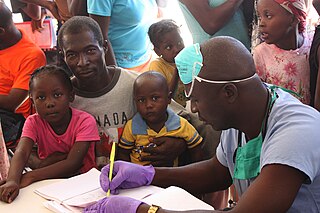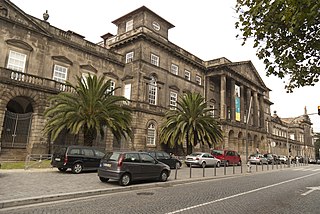Related Research Articles

The United States Department of Health and Human Services (HHS) is a cabinet-level executive branch department of the U.S. federal government created to protect the health of the U.S. people and providing essential human services. Its motto is "Improving the health, safety, and well-being of America". Before the separate federal Department of Education was created in 1979, it was called the Department of Health, Education, and Welfare (HEW).

The Health Resources and Services Administration (HRSA) is an agency of the U.S. Department of Health and Human Services located in North Bethesda, Maryland. It is the primary federal agency for improving access to health care services for people who are uninsured, isolated or medically vulnerable.

Partners In Health (PIH) is an international nonprofit public health organization founded in 1987 by Paul Farmer, Ophelia Dahl, Thomas J. White, Todd McCormack, and Jim Yong Kim.
Medical Emergency Relief International (MERLIN) is a former British international non-governmental health charity which sent medical experts to global emergencies.
A public hospital, or government hospital, is a hospital which is government owned and is predominantly funded by the government and operates predominantly off the money that is collected from taxpayers to fund healthcare initiatives. In almost all the developed countries but the United States of America, and in most of the developing countries, this type of hospital provides medical care almost free of charge to patients, covering expenses and wages by government reimbursement.

The Department of Health is the executive department of the government of the Philippines responsible for ensuring access to basic public health services by all Filipinos through the provision of quality health care, the regulation of all health services and products. It is the government's over-all technical authority on health. It has its headquarters at the San Lazaro Compound, along Rizal Avenue in Manila.
The Winnipeg Regional Health Authority is the governing body for healthcare regulation for the City of Winnipeg, the northern community of Churchill, and the Rural Municipalities of East and West St. Paul, in the Canadian province of Manitoba. The WRHA also provides health-care support and specialty referral services to those Manitobans who live out of these boundaries, as well as residents of northwestern Ontario and Nunavut.

The Wisconsin Department of Corrections (WIDOC) is an administrative department in the executive branch of the state of Wisconsin responsible for corrections in Wisconsin, including state prisons and community supervision. The secretary is a cabinet member appointed by the governor of Wisconsin and confirmed by the Wisconsin Senate.

Healthcare in Senegal is a center topic of discourse in understanding the well-being and vitality of the Senegalese people. As of 2008, there was a need to improve Senegal's infrastructure to promote a healthy, decent living environment for the Senegalese.

Healthcare in Portugal is provided through three coexisting systems: the National Health Service, special social health insurance schemes for certain professions and voluntary private health insurance. The SNS provides universal coverage, although in 2012 measures were implemented to ensure the sustainability of the service by the introduction of user fees to be paid for at the end of treatments. In addition, about 25% of the population is covered by the health subsystems, 10% by private insurance schemes and another 7% by mutual funds. The Ministry of Health is responsible for developing health policy as well as managing the SNS. The Health Regulatory Entity (ERS) is the public independent entity responsible for the regulation of the activity of all the public, private and social healthcare providers. In 2019 the government proposes to scrap all fees, which constitute about 2 percent of the NHS's budget, apart from some hospital emergencies.

The Philippine Health Insurance Corporation (PhilHealth) was created in 1995 to implement universal health coverage in the Philippines. It is a tax-exempt, government-owned and controlled corporation (GOCC) of the Philippines, and is attached to the Department of Health. On August 4, 1969, Republic Act 6111 or the Philippine Medical Care Act of 1969 was signed by President Ferdinand E. Marcos which was eventually implemented in August 1971.
Area Resources for Community and Human Services (ARCHS) is a not-for-profit organization that designs, manages, and evaluates education and social service programs. ARCHS is contracted to serve as the official "Community Partnership" for Greater St. Louis on behalf of the State of Missouri – one of 20 similar organizations across Missouri.
The public healthcare system in India evolved due to a number of influences since 1947, including British influence from the colonial period. The need for an efficient and effective public health system in India is large.
The Office on Women's Health (OWH) is part of the U.S. Department of Health and Human Services (DHHS) and functions to improve the health and well-being of U.S. women and girls. The main headquarters, from which the OWH operate, is located in Washington, DC with ten other regional women's health coordinators positioned across the country to implement local health initiatives.

In the past, Kosovo’s capabilities to develop a modern health care system were limited. Low GDP during 1990 worsened the situation even more. However, the establishment of the Faculty of Medicine in the University of Pristina marked a significant development in health care. This was also followed by launching different health clinics which enabled better conditions for professional development.

The White House Initiative on Asian Americans, Native Hawaiians, and Pacific Islanders (WHIAANHPI) is a United States governmental office that coordinates an ambitious whole-of-government approach to advance equity, justice, and opportunity for Asian Americans, Native Hawaiians, and Pacific Islanders. The Initiative collaborates with the Deputy Assistant to the President and AA and NHPI Senior Liaison, White House Office of Public Engagement and designated federal departments and agencies to advance equity, justice, and opportunity for AA and NHPIs in the areas of economic development, education, health and human services, housing, environment, arts, agriculture, labor and employment, transportation, justice, veterans affairs, and community development.

Voluntary Health Services, popularly known as the VHS Hospital, is a multispecialty tertiary care referral hospital in the south Indian state of Tamil Nadu, reportedly serving the economically weaker sections of the society. It was founded in 1958 by Krishnaswami Srinivas Sanjivi, an Indian physician, social worker and a winner of Padma Shri and Padma Bhushan awards and is run by a charitable non governmental organization of the same name. The hospital is situated along Rajiv Gandhi Salai at Taramani, in Chennai.
Abortion in Guam is legal under territorial law, but the absence of abortion providers in the territory means that it is effectively impossible to receive abortion services.

Guam, one of the external territories of the United States of America confirmed its first case of the COVID-19 pandemic on March 15, 2020, and the first death on March 22. The Government of Guam ordered the general lockdown of the island in mid-March. Governor Lou Leon Guerrero announced the implementation of a four-step "Pandemic Condition of Readiness" (PCOR) on April 30, 2020. Travelers to Guam from designated high-risk areas must provide a recent negative COVID-19 test or undergo mandatory quarantine in a government-approved facility. Guam moved from PCOR 1 to PCOR 2 on May 10, allowing some business activity with restrictions, and then to PCOR 3 on July 20. An outbreak in mid-August was not controlled for several months, resulting in the 7-day rolling test positivity rate to spike above 15% in early October 2020, as well as infections in both the Governor and Lieutenant Governor. Guam announced a return to the lockdown conditions of PCOR 1 on August 14 to control the outbreak, which was not loosened to PCOR 2 until January 15, 2021. It was further relaxed to PCOR 3 on February 21, 2021. From December 2020 to July 2021 cases stayed very low until a surge in August 2021 largely as a result of the delta variant. By October 2021, 90% of the population was vaccinated.
Alberta's Ministry of Health is a ministry of the Executive Council of Alberta whose major responsibilities include setting "policy and direction to achieve a sustainable and accountable health system to promote and protect the health of Albertans."
References
- ↑ "Department of Public Health and Social Services". Guam Department of Health and Social Services (DPHSS). 2020. Retrieved 22 April 2022.
- ↑ "Division of Public Health". Guam Department of Public Health and Social Services, Regional Health Clinics. 2021. Retrieved 22 April 2022.